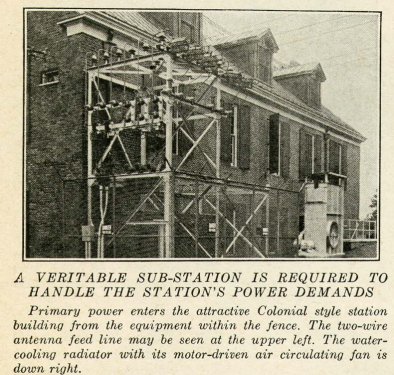|
and UV-862 tubes is supplied by the 350-kw. unit employing six UV-857 mercury-vapor type rectifiers
in a three phase "series" circuit. This rectifier is the first of its type to be used in a
commercial installation. The UV-857 is the jumbo version of the familiar UX-866 and has a peak
inverse voltage rating of 20,000 and a peak current rating of 20 amperes. The d.c. output voltage is
normally 18,000 and is varied by means of a motor-operated voltage regulator in the 2300-volt
primary circuit of the three single-phase plate supply transformers. The output voltage is dropped
to 15,000 for the two UV-863 tubes in the 5-kw. stage; the full rectifier output voltage is applied
to the plates of the UV-862 tubes in the 50-kw. stage. The rectifier output is filtered by a large
reactor and bank of high-voltage condensers.
___Filament current for the UV-863 and UV-862 tubes is supplied by a d.c. generator equipped

with a filter rather than by step-down transformers. The use of filtered direct current for filament
heating is essential for the prevention of hum in the output when heavy filament currents are
employed. Several hundred amperes of alternating current flowing through a filament would create a
fluctuating field of considerable intensity. Alternating current from step-down transformers is used
for filament heating of the rectifier tubes as well as for the filaments of the transmitting tubes
of the lower stages.
___Negative grid bias voltage for all tubes following the crystal oscillator-amplifier is supplied
by a d.c.generator. This method of obtaining bias insures good voltage regulation.
THE WATER-COOLING SYSTEM AND POWER CONTROL
___The development of the water-cooled type tube has made necessary similar developments in the
water system involved and this installation has |
|
a water system which in itself is a considerable plant. Distilled water only is used and an
important unit of the system is the perfectly legal still located in the basement of the station
building. The pure water distilled by this unit is put in a storage tank from which it is pumped
through the outdoor radiator and the tubes. When the transmitter is shut down and the pumps stop,
the water automatically drains from the outside radiator to the storage tank in the basement. This
eliminates the danger of a possible freeze-up in cold weather.
___The use of distilled water has several advantages over the use of doubtfully pure "tap" water.
Corrosion and "scaling" of the copper jackets of the tubes is minimzed and the comparatively high
resistance of the distilled water permits operation of the plates at high potential with respect to
ground with negligible power loss. The water flows through coils of rubber hose immediately after
leaving them. This increases the length of the water column and of the high-resistance path to
ground.
___When the transmitter is put into operation, the water pumps automatically start circulation some
time before the filament and plate power comes on and the water is kept circulating for some fifteen
minutes after the rest of the plant is shut down to insure proper gradual cooling of the tubes.
___Power to the transmitter is controlled by an elaborate system of automatic switches which operate
in proper sequence and with proper timing. The whole transmitter is controlled by a single push-
button start-and-stop switch. Pilot lamps indicate current flow in all important circuits and assist
greatly in locating the source of trouble in event of a forced shut-down. The transmitter can be
easily controlled by a single operator, although the technical staff of WTIC is made up of three
engineers and eight operators at the present time.
CONCLUSION
___Obviously it has been impossible to cover in complete detail every interesting feature of this
modern 50-kw. transmitter. An attempt has been made, however to dwell particularly on those features
of greatest interest to the amateur and it is hoped that ingenious experimenters will find ways and
means of applying some of the ideas to our game. It is more than probable that many applications
will be discovered in addition to those suggested in these pages. Some may prove of great value to
amateur radio; all will be worth trying. |